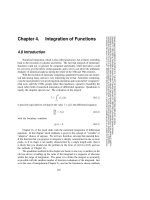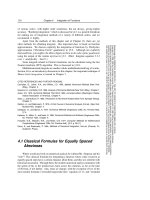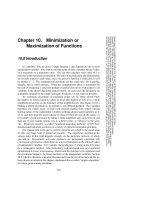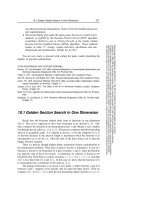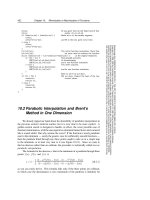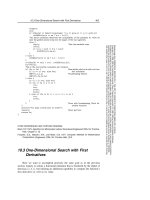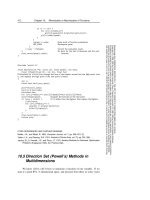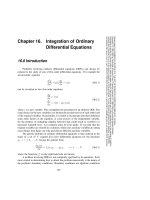Integration of Functions part 1
Bạn đang xem bản rút gọn của tài liệu. Xem và tải ngay bản đầy đủ của tài liệu tại đây (45.84 KB, 2 trang )
Sample page from NUMERICAL RECIPES IN C: THE ART OF SCIENTIFIC COMPUTING (ISBN 0-521-43108-5)
Copyright (C) 1988-1992 by Cambridge University Press.Programs Copyright (C) 1988-1992 by Numerical Recipes Software.
Permission is granted for internet users to make one paper copy for their own personal use. Further reproduction, or any copying of machine-
readable files (including this one) to any servercomputer, is strictly prohibited. To order Numerical Recipes books,diskettes, or CDROMs
visit website or call 1-800-872-7423 (North America only),or send email to (outside North America).
Chapter 4. Integration of Functions
4.0 Introduction
Numerical integration,which is also called quadrature, has a history extending
back to the invention of calculus and before. The fact that integrals of elementary
functions could not, in general, be computed analytically, while derivatives could
be, served to give the field a certain panache, and to set it a cut above the arithmetic
drudgery of numerical analysis during the whole of the 18th and 19th centuries.
With the invention of automatic computing, quadrature became just one numer-
ical task among many, and not a very interesting one at that. Automatic computing,
even the most primitivesort involvingdesk calculators and roomsfull of “computers”
(that were, until the 1950s, people rather than machines), opened to feasibility the
much richer field of numerical integration of differential equations. Quadrature is
merely the simplest special case: The evaluation of the integral
I =
b
a
f(x)dx (4.0.1)
is precisely equivalent to solving for the value I ≡ y(b) the differential equation
dy
dx
= f(x)(4.0.2)
with the boundary condition
y(a)=0 (4.0.3)
Chapter 16 of this book deals with the numerical integration of differential
equations. In that chapter, much emphasis is given to the concept of “variable” or
“adaptive” choices of stepsize. We will not, therefore, develop that material here.
If the function that you propose to integrate is sharply concentrated in one or more
peaks, or if its shape is not readily characterized by a single length-scale, then it
is likely that you should cast the problem in the form of (4.0.2)–(4.0.3) and use
the methods of Chapter 16.
The quadrature methods in this chapter are based, in one way or another, on the
obvious device of adding up the value of the integrand at a sequence of abscissas
within the range of integration. The game is to obtain the integral as accurately
as possible with the smallest number of function evaluations of the integrand. Just
as in the case of interpolation (Chapter 3), one has the freedom to choose methods
129
130
Chapter 4. Integration of Functions
Sample page from NUMERICAL RECIPES IN C: THE ART OF SCIENTIFIC COMPUTING (ISBN 0-521-43108-5)
Copyright (C) 1988-1992 by Cambridge University Press.Programs Copyright (C) 1988-1992 by Numerical Recipes Software.
Permission is granted for internet users to make one paper copy for their own personal use. Further reproduction, or any copying of machine-
readable files (including this one) to any servercomputer, is strictly prohibited. To order Numerical Recipes books,diskettes, or CDROMs
visit website or call 1-800-872-7423 (North America only),or send email to (outside North America).
of various orders, with higher order sometimes, but not always, giving higher
accuracy. “Romberg integration,” which is discussed in §4.3, is a general formalism
for making use of integration methods of a variety of different orders, and we
recommend it highly.
Apart from the methods of this chapter and of Chapter 16, there are yet
other methods for obtaining integrals. One important class is based on function
approximation. We discuss explicitly the integration of functions by Chebyshev
approximation (“Clenshaw-Curtis” quadrature) in §5.9. Although not explicitly
discussed here, you ought to be able to figure out how to do cubic spline quadrature
using the output of the routine spline in §3.3. (Hint: Integrate equation 3.3.3
over x analytically. See
[1]
.)
Some integrals related to Fourier transforms can be calculated using the fast
Fourier transform (FFT) algorithm. This is discussed in §13.9.
Multidimensional integrals are another whole multidimensional bag of worms.
Section 4.6 is an introductory discussion in this chapter; the important technique of
Monte-Carlo integration is treated in Chapter 7.
CITED REFERENCES AND FURTHER READING:
Carnahan, B., Luther, H.A., and Wilkes, J.O. 1969,
Applied Numerical Methods
(New York:
Wiley), Chapter 2.
Isaacson, E., and Keller, H.B. 1966,
Analysis of Numerical Methods
(New York: Wiley), Chapter 7.
Acton, F.S. 1970,
Numerical Methods That Work
; 1990, corrected edition (Washington: Mathe-
matical Association of America), Chapter 4.
Stoer, J., and Bulirsch, R. 1980,
Introduction to Numerical Analysis
(New York: Springer-Verlag),
Chapter 3.
Ralston, A., and Rabinowitz, P. 1978,
A First Course in Numerical Analysis
, 2nd ed. (New York:
McGraw-Hill), Chapter 4.
Dahlquist, G., and Bjorck, A. 1974,
Numerical Methods
(Englewood Cliffs, NJ: Prentice-Hall),
§
7.4.
Kahaner, D., Moler, C., and Nash, S. 1989,
Numerical Methods and Software
(Englewood Cliffs,
NJ: Prentice Hall), Chapter 5.
Forsythe, G.E., Malcolm, M.A., and Moler, C.B. 1977,
Computer Methods for Mathematical
Computations
(Englewood Cliffs, NJ: Prentice-Hall),
§
5.2, p. 89. [1]
Davis, P., and Rabinowitz, P. 1984,
Methods of Numerical Integration
, 2nd ed. (Orlando, FL:
Academic Press).
4.1 Classical Formulas for Equally Spaced
Abscissas
Where would any book on numerical analysis be without Mr. Simpson and his
“rule”? The classical formulas for integrating a function whose value is known at
equally spaced steps have a certain elegance about them, and they are redolent with
historical association. Through them, the modern numerical analyst communes with
the spirits of his or her predecessors back across the centuries, as far as the time
of Newton, if not farther. Alas, times do change; with the exception of two of the
most modest formulas (“extended trapezoidal rule,” equation 4.1.11, and “extended
